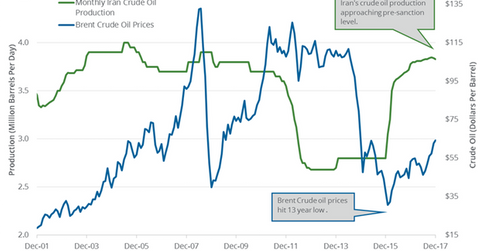Possible Sanctions against Iran Could Impact Crude Oil Prices
Any increase in Iran’s crude oil production has a negative impact on oil prices. Lower oil (OIL) (DBO) prices are bearish for energy producers (IXC) (FXN).
Jan. 16 2018, Updated 10:43 a.m. ET

Iran and the US
On January 12, 2018, President Trump waived new sanctions on Iran. He reviews the sanctions on Iran every three months. He warned European allies like the United Kingdom, France, and Germany to work on the “terrible flaws” in the Iran nuclear pact.
Any lower compliance to the nuclear accord could lead to new sanctions against Iran. It could raise geopolitical tensions between the US and Iran. It could have a negative impact on Iran’s crude oil production and supplies, which is bullish for oil (BNO) (DBO) (USO) prices.
Iran’s crude oil production
According to the EIA, Iran’s crude oil production fell by 10,000 bpd (barrels per day) to 3,830,000 bpd in December 2017—compared to the previous month. However, production rose by 50,000 bpd or 1.3% from a year ago. Production was near a nine-year high. The US lifted sanctions on Iran in January 2016.
Any increase in Iran’s crude oil production has a negative impact on oil prices. Lower oil (OIL) (DBO) prices are bearish for energy producers (IXC) (FXN) like Gulfport Energy (GPOR), Oasis Petroleum (OAS), and Denbury Resources (DNR). They also impact funds like the Guggenheim S&P Equal Weight Energy (RYE) and the iShares U.S. Energy ETF (IYE).
Iran and the production cut deal
Iran supported prolonging the production cuts until December 2018. As part of the deal, Iran is allowed to cap production at ~3,800,000 bpd.
Iran’s crude oil production plans
Iran’s crude oil production averaged 3.51 MMbpd (million barrels per day) and 3.82 MMbpd in 2016 and 2017. Iran targets to increase its oil production to 4.7 MMbpd by 2021. The increase in production could pressure oil (USO) (USL) prices. However, any new sanctions or a supply outage could support oil (SCO) prices.
Next, we’ll discuss Cushing oil inventories.
